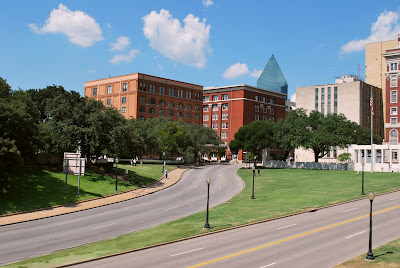Freedman’s Cemetery Memorial
 |
| The Dallas Uptown skyline looms behind the Freeman's Cemetery Memorial. I like this view because of the combination of past and present. |
On the
corner of Lemmon Avenue and North Central Expressway lies an often overlooked
piece of Dallas history. I myself drove past it several times in the years I
lived in Dallas without realizing what I was driving past. From the outside, it
appears to be nothing more than a green space or park intended to offer a
little scenery. But those willing to walk up and examine it closer will find
that the fenced off green area is actually a stark reminder of the city’s
troubled past.
 |
| These photos show the walkway toward the central monument. The figures pictured in the middle represent freed slaves. |
A plaque
next to Freedman’s Cemetery Memorial states that the area near what is now Uptown was
once home to a settlement of freed slaves following the United States Civil War
that was known as Freedmantown. In 1869, an acre of land was used to establish
a graveyard for African Americans, which was expanded to four acres in 1879.
This settlement became part of the City of Dallas in 1912. Despite
emancipation, segregation and racism were still prevalent in Dallas for many
years. By the 1930s, construction began on North Central Expressway, wiping out
almost all of the cemetery. The memorial park and cemetery were established in
1965, and preservation efforts began in 1989 in anticipation of the expansion
of the highway.
As this
New York Times article from 1990 points out, the unearthing of the cemetery
was a long and arduous process that delayed highway expansion as archaeologists attempted to keep family groups together and understand more of the history
before simply moving the remains as required by Texas law. Much of the
artifacts from the cemetery are now part of the Freedman’s Cemetery Collection
at the African American Museum in Fair
Park. The museum currently has an ongoing exhibition called “Facing the Rising
Sun Freedman’s Cemetery” that gives visitors a glimpse at the history of this
area.
Today, a half-acre
of green land is enclosed by a pink granite arch with stunning bronze
statues by artist David Newton
that were installed in 2000, according to his web site. The symbolism can’t be
missed as strong African figures adorn the entryway to the memorial, while
chained, distraught slaves frame the exit. In lieu of gravestones, there is a
central figure of a free man holding a free woman in front of granite etched with
the poem “Here” by Nia Akimbo. Along the walls of the entrance are ten children’s
poems chosen in a Dallas schoolchildren’s poetry contest according to this
North Dallas Gazette article from 2002. The article summarizes the
symbolism far more aptly than I ever could, so I encourage you to check it out.
Please note that the article “Freedman’s Town” does continue about halfway down
on the second page but appears to have been mislabeled due to a design flaw.
 |
| On the other side of "Warrior" is "Struggling Soul". |
 |
| "Griot", which means "storyteller", guards the other half of the entrance. |
 |
| On the other side of "Griot" is "Violated Soul". |
The
memorial is definitely worth a visit, but keep in mind that the adjacent Temple
Emanu-El Cemetery is still an active graveyard that may have burial services in
progress. Admission is free.
 |
| Toward the top of the granite arch are these smaller African figures |
Freedman’s
Cemetery Memorial
2904 Floyd
Street, Dallas, TX 75205
(214)
670-3284





Comments
Post a Comment